Abstract
BACKGROUND AND AIMS: To compare extracorporeal shock wave lithotripsy (ESWL) and laser induced shock wave lithotripsy (LISL) of retained bile duct stones to stone free rate, number of therapeutic sessions, and costs. PATIENTS: Thirty four patients were randomly assigned to either ESWL or LISL therapy. The main reasons for failure of standard endoscopy were due to stone impaction (n = 12), biliary stricture (n = 8), or large stone diameter (n = 14). METHODS: An extracorporeal piezoelectic lithotripter with ultrasonic guidance and a rhodamine 6G laser with an integrated stone tissue detection system were used. LISL was performed exclusively under radiological control. RESULTS: Using the initial methods complete stone fragmentation was achieved in nine of 17 patients (52.4%) of the ESWL group and in 14 of 17 patients (82.4%) in the LISL group, or combined with additional fragmentation techniques 31 of the 34 patients (91.2%) were stone free at the end of treatment. In comparison LISL tended to be more efficient in clearing the bile ducts (p = 0.07, NS). Significantly less fragmentation sessions (1.29 v 2.82; p = 0.0001) and less additional endoscopic sessions (0.65 v 1.6; p = 0.002) were necessary in the LISL group. There were no major complications in either procedure. CONCLUSIONS: Compared with ESWL, fluoroscopically guided LISL achieves stone disintegration more rapidly and with significantly less treatment sessions, which leads to a significant reduction in cost.
Full text
PDF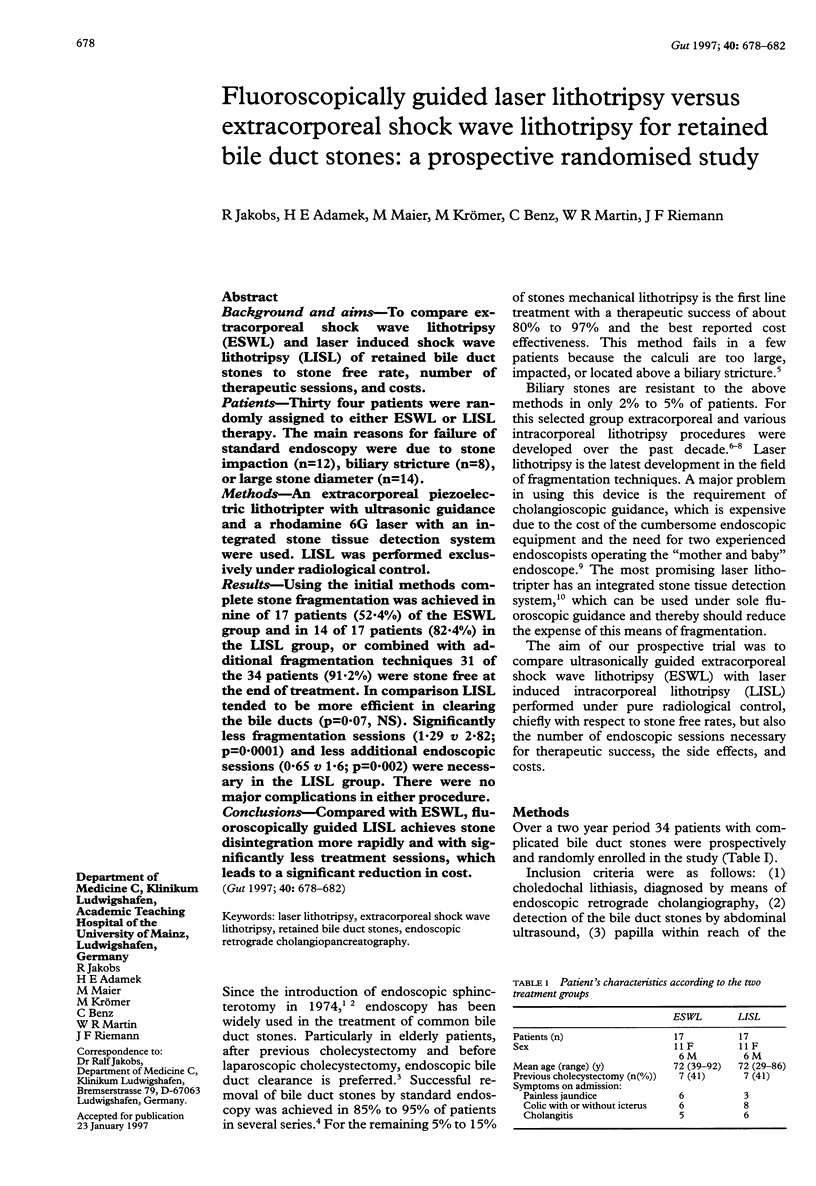
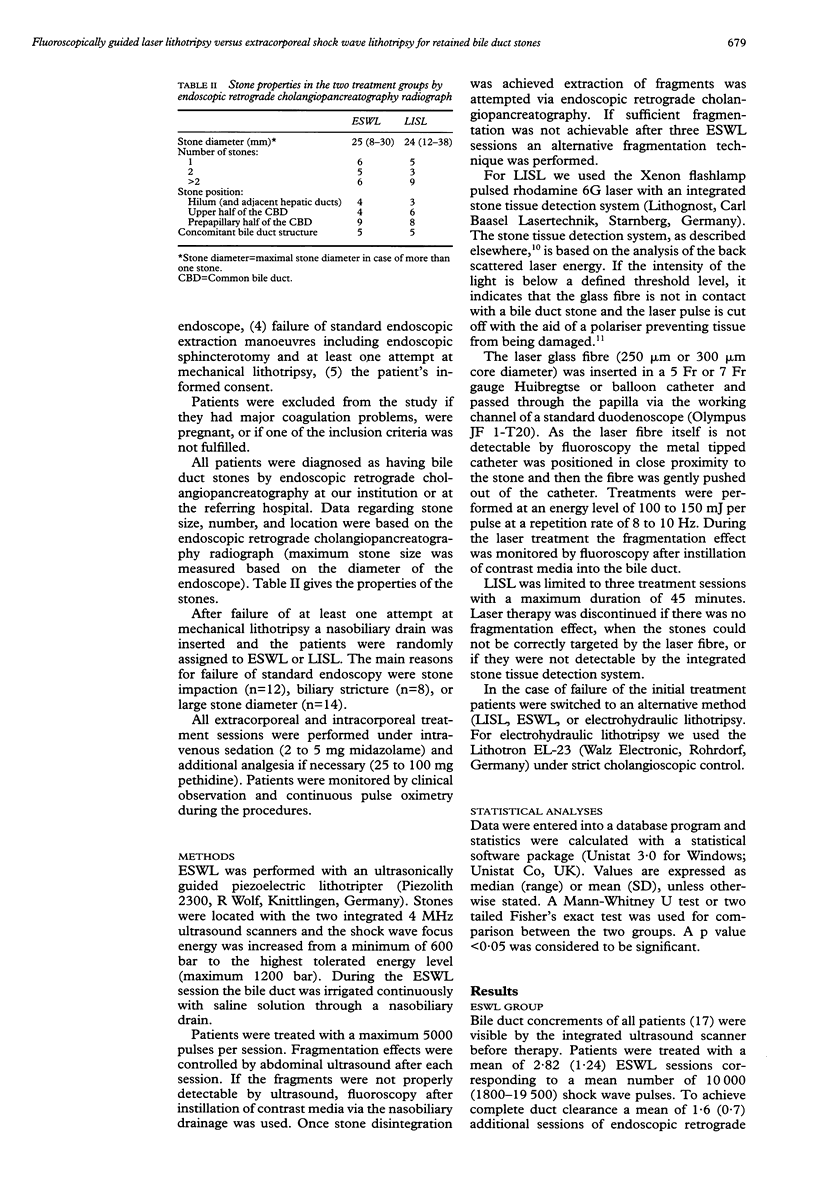
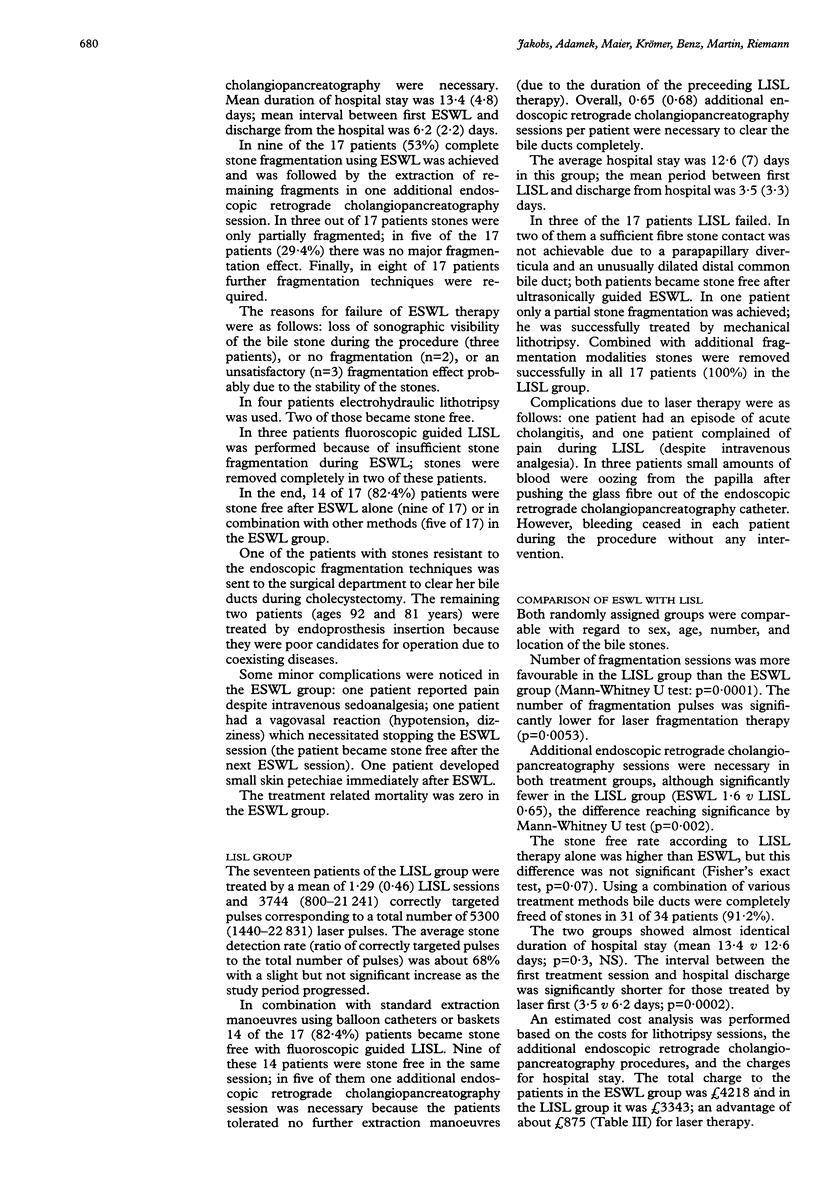
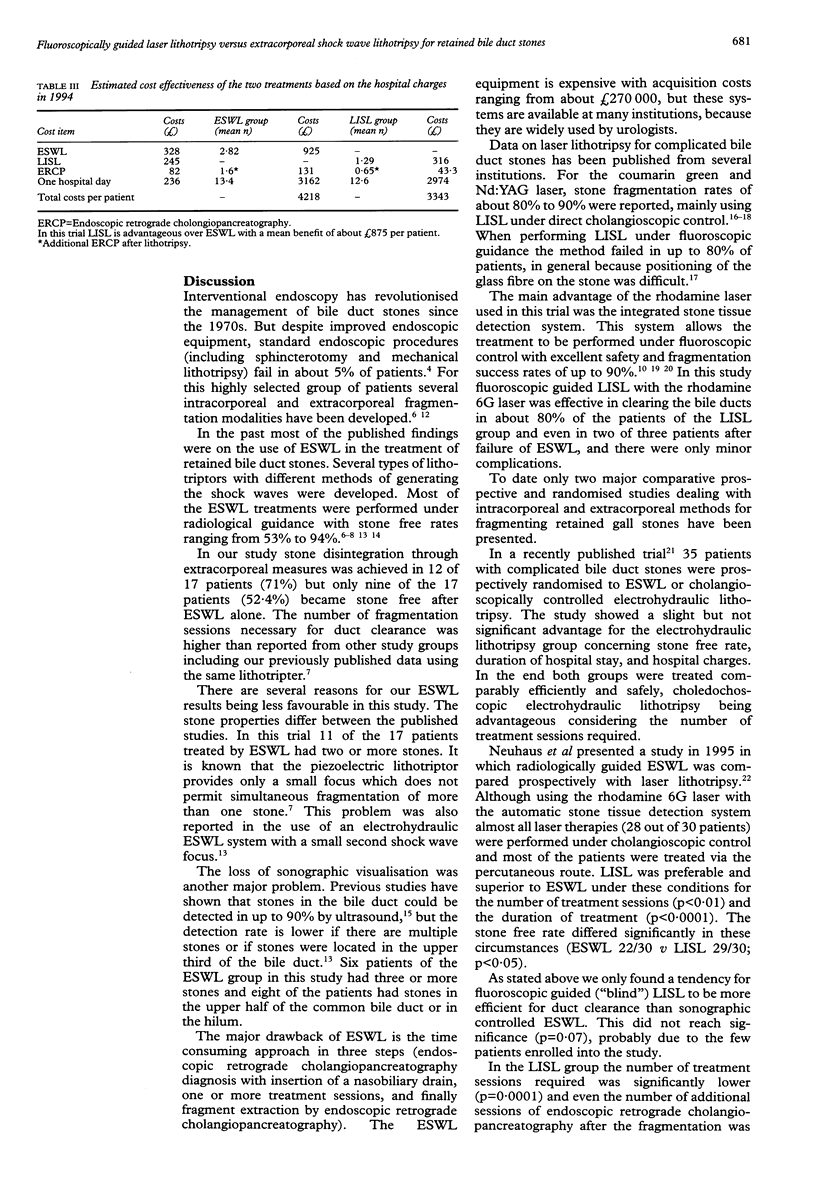
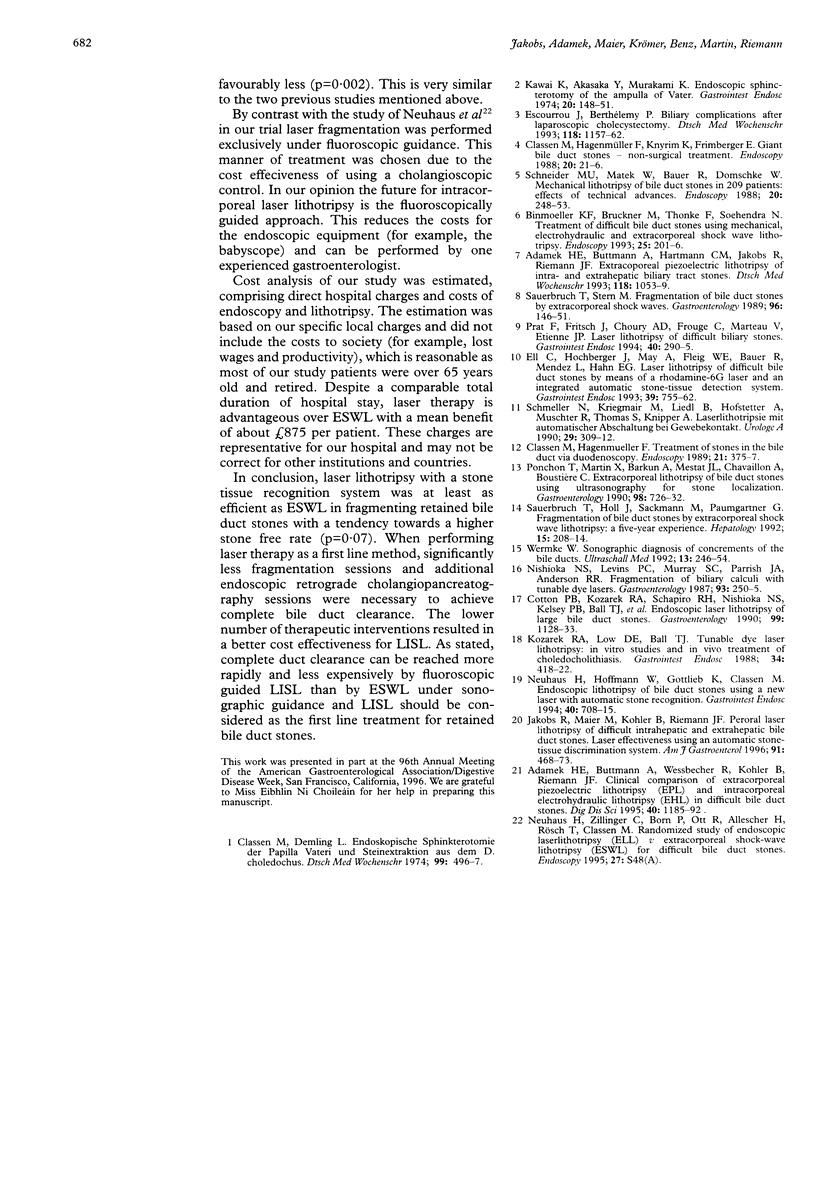
Selected References
These references are in PubMed. This may not be the complete list of references from this article.
- Adamek H. E., Buttmann A., Hartmann C. M., Jakobs R., Riemann J. F. Extrakorporale piezoelektrische Lithotripsie von intra- und extrahepatischen Gallengangssteinen. Dtsch Med Wochenschr. 1993 Jul 23;118(29-30):1053–1059. doi: 10.1055/s-2008-1059425. [DOI] [PubMed] [Google Scholar]
- Adamek H. E., Buttmann A., Wessbecher R., Kohler B., Riemann J. F. Clinical comparison of extracorporeal piezoelectric lithotripsy (EPL) and intracorporeal electrohydraulic lithotripsy (EHL) in difficult bile duct stones. A prospective randomized trial. Dig Dis Sci. 1995 Jun;40(6):1185–1192. doi: 10.1007/BF02065522. [DOI] [PubMed] [Google Scholar]
- Binmoeller K. F., Brückner M., Thonke F., Soehendra N. Treatment of difficult bile duct stones using mechanical, electrohydraulic and extracorporeal shock wave lithotripsy. Endoscopy. 1993 Mar;25(3):201–206. doi: 10.1055/s-2007-1010293. [DOI] [PubMed] [Google Scholar]
- Classen M., Demling L. Endoskopische Sphinkterotomie der Papilla Vateri und Steinextraktion aus dem Ductus choledochus. Dtsch Med Wochenschr. 1974 Mar 15;99(11):496–497. doi: 10.1055/s-0028-1107790. [DOI] [PubMed] [Google Scholar]
- Classen M., Hagenmüller F., Knyrim K., Frimberger E. Giant bile duct stones--non-surgical treatment. Endoscopy. 1988 Jan;20(1):21–26. doi: 10.1055/s-2007-1018119. [DOI] [PubMed] [Google Scholar]
- Classen M., Hagenmüller F. Treatment of stones in the bile duct via duodenoscopy. Endoscopy. 1989 Dec;21 (Suppl 1):375–377. doi: 10.1055/s-2007-1012995. [DOI] [PubMed] [Google Scholar]
- Cotton P. B., Kozarek R. A., Schapiro R. H., Nishioka N. S., Kelsey P. B., Ball T. J., Putnam W. S., Barkun A., Weinerth J. Endoscopic laser lithotripsy of large bile duct stones. Gastroenterology. 1990 Oct;99(4):1128–1133. doi: 10.1016/0016-5085(90)90634-d. [DOI] [PubMed] [Google Scholar]
- Ell C., Hochberger J., May A., Fleig W. E., Bauer R., Mendez L., Hahn E. G. Laser lithotripsy of difficult bile duct stones by means of a rhodamine-6G laser and an integrated automatic stone-tissue detection system. Gastrointest Endosc. 1993 Nov-Dec;39(6):755–762. doi: 10.1016/s0016-5107(93)70259-x. [DOI] [PubMed] [Google Scholar]
- Escourrou J., Berthélemy P. Biliäre Komplikationen nach laparoskopischer Cholezystektomie. Endoskopische retrograde Cholangiopankreatographie in Diagnostik und Therapie. Dtsch Med Wochenschr. 1993 Aug 13;118(32):1157–1162. doi: 10.1055/s-2008-1059439. [DOI] [PubMed] [Google Scholar]
- Jakobs R., Maier M., Kohler B., Riemann J. F. Peroral laser lithotripsy of difficult intrahepatic and extrahepatic bile duct stones: laser effectiveness using an automatic stone-tissue discrimination system. Am J Gastroenterol. 1996 Mar;91(3):468–473. [PubMed] [Google Scholar]
- Kawai K., Akasaka Y., Murakami K., Tada M., Koli Y. Endoscopic sphincterotomy of the ampulla of Vater. Gastrointest Endosc. 1974 May;20(4):148–151. doi: 10.1016/s0016-5107(74)73914-1. [DOI] [PubMed] [Google Scholar]
- Kozarek R. A., Low D. E., Ball T. J. Tunable dye laser lithotripsy: in vitro studies and in vivo treatment of choledocholithiasis. Gastrointest Endosc. 1988 Sep-Oct;34(5):418–421. doi: 10.1016/s0016-5107(88)71408-x. [DOI] [PubMed] [Google Scholar]
- Neuhaus H., Hoffmann W., Gottlieb K., Classen M. Endoscopic lithotripsy of bile duct stones using a new laser with automatic stone recognition. Gastrointest Endosc. 1994 Nov-Dec;40(6):708–715. [PubMed] [Google Scholar]
- Nishioka N. S., Levins P. C., Murray S. C., Parrish J. A., Anderson R. R. Fragmentation of biliary calculi with tunable dye lasers. Gastroenterology. 1987 Aug;93(2):250–255. doi: 10.1016/0016-5085(87)91010-9. [DOI] [PubMed] [Google Scholar]
- Ponchon T., Martin X., Barkun A., Mestas J. L., Chavaillon A., Boustière C. Extracorporeal lithotripsy of bile duct stones using ultrasonography for stone localization. Gastroenterology. 1990 Mar;98(3):726–732. doi: 10.1016/0016-5085(90)90295-c. [DOI] [PubMed] [Google Scholar]
- Prat F., Fritsch J., Choury A. D., Frouge C., Marteau V., Etienne J. P. Laser lithotripsy of difficult biliary stones. Gastrointest Endosc. 1994 May-Jun;40(3):290–295. doi: 10.1016/s0016-5107(94)70058-3. [DOI] [PubMed] [Google Scholar]
- Sauerbruch T., Holl J., Sackmann M., Paumgartner G. Fragmentation of bile duct stones by extracorporeal shock-wave lithotripsy: a five-year experience. Hepatology. 1992 Feb;15(2):208–214. doi: 10.1002/hep.1840150207. [DOI] [PubMed] [Google Scholar]
- Sauerbruch T., Stern M. Fragmentation of bile duct stones by extracorporeal shock waves. A new approach to biliary calculi after failure of routine endoscopic measures. Gastroenterology. 1989 Jan;96(1):146–152. doi: 10.1016/0016-5085(89)90775-0. [DOI] [PubMed] [Google Scholar]
- Schmeller N., Kriegmair M., Liedl B., Hofstetter A., Muschter R., Thomas S., Knipper A. Laserlithotripsie mit automatischer Abschaltung bei Gewebekontakt. Urologe A. 1990 Nov;29(6):309–312. [PubMed] [Google Scholar]
- Schneider M. U., Matek W., Bauer R., Domschke W. Mechanical lithotripsy of bile duct stones in 209 patients--effect of technical advances. Endoscopy. 1988 Sep;20(5):248–253. doi: 10.1055/s-2007-1018186. [DOI] [PubMed] [Google Scholar]
- Wermke W. Sonographische Diagnostik von Gallenwegskonkrementen. Eine prospektive Studie hinsichtlich der Auswirkungen objektiver und subjektiver Faktoren auf die Treffsicherheit bei Choledocholithiasis. Ultraschall Med. 1992 Dec;13(6):246–254. doi: 10.1055/s-2007-1005318. [DOI] [PubMed] [Google Scholar]


